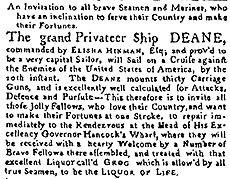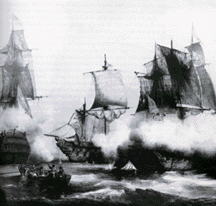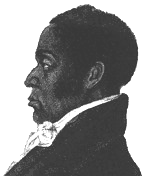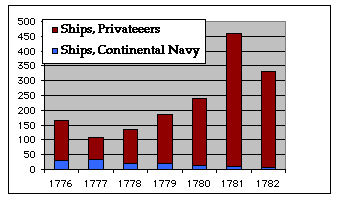
Privateers
Because of British policy regarding import of gunpowder, the colonists
did not have enough to repel the third British charge at Bunker Hill.
A survey by George Washington at the time showed army stockpiles
were sufficient for 9 rounds per man. By 1777, the privateers
and merchantmen brought in over 2 million pounds of gunpowder and
saltpeter. A typical New England privateer carried two or three
African-Americans who had long found employment in the fishing industry.
The General Putnam from New London, Connecticut, had 4 blacks
on board; the Aurora had 3. In Salem, Massachusetts, Titus,
a slave owned by Mrs. John Cabot, ran a successful business recruiting
blacks as privateers.
Privateer John Manley
captured the Nancy, supplying the American army with 2,000 muskets,
31 tons of musket shot, 7,000 round-shot for cannon, and other ammunition.
Captain Jonathan Haraden from Salem, Massachusetts, who captured
1,000 British cannon, was considered one of the best sea-fighters, successfully
taking on three armed British ships at the same time. Privateers captured
countless British reinforcements and over 10,000 seamen, keeping them
out of the British Navy.
In 1777 George Washington's
armies totaled about 11,000 men. At the same time there were 11,000
privateers at sea intercepting British shipping in the Atlantic, Caribbean,
and even between Ireland and England.
Together, the Continental
Navy and privateers captured 16,000 British prisoners, a substantial
contribution in comparison with the 15,000 prisoners taken by the entire
Continental Army before the surrender at Yorktown. The crew of the privateers
were well paid for their hazardous work, earning as much as $1,000 for
one voyage, while average pay at the time was $9 per month.

Two unidentified American
privateers battle two British ships
Joshua Barney
Joshua Barney was captured
by the British while serving in the Continental Navy. He and his shipmates
were kept on board in 3 foot high boxes for 53 days with minimal food
and water. Upon arrival in England, he was imprisoned, but escaped with
the help of a friendly guard. He returned to the Colonies to captain
the privateer Hyder Ally, where he gained fame by tricking the
British General Monk. As the two ships drew near, he shouted
to the General Monk "Hard-a-port your helm," but had
instructed his helmsman to do the opposite. The ships collided as planned,
and Hyder Ally lashed her prize alongside.
 James Forten, African-American
Privateer
James Forten, African-American
Privateer
James Forten (1766-1843)
was a 15 year-old powder boy on the privateer Royal Louis, commanded
by Stephen Decatur, Sr. He was born free in Philadelphia and
had already served as a drummer in the Continental Army.
The Royal Louis had
a crew of 200, 20 of them African-Americans. During her first
cruise as a privateer she captured a British Navy brig. On her second
cruise she met the heavily armed British frigate Amphylon and
two others, and was forced to surrender.
Portrait of James Forten,
at right
Young James Forten
expected to be sold into slavery in the West Indies, as was British
custom with their black prisoners of war. However, on board the Amphylon
he was befriended by the captain's son, a boy his age, who persuaded
his father to send Forten to England. Forten refused to be a traitor
to his country, and the captain sent him to the prison-ship Jersey
[see below], along with a letter asking he be treated kindly and
exchanged if possible.
Forten spent 7 months on
the Jersey sharing moldy bread and foul water with a thousand
other privateers. Once, he had a chance to escape by hiding in the baggage
of an officer being exchanged for a British prisoner, but he allowed
a younger white boy to take the space. Forten helped carry the chest
off the Jersey. He was set free in an exchange of prisoners and
walked home from New York to Philadelphia, where he became a successful
businessman and a founder of the Abolitionist movement.
The Prison Ships
About 55,000 American seamen served aboard the privateers. When captured
by the British Navy, they were given a choice: join the British Navy or
prison. The conditions of captivity aboard the prison ships, mostly abandoned
ships moored in New York harbor, were inhuman. The most infamous of these
was the HMS Jersey. About 11,000 privateers died of disease and
malnutrition, their bodies dumped onto the mud flats of Wallabout Bay,
where Brooklyn Navy Yard now stands.
These Mariners lost their
lives in the founding of our Nation and were a major factor in the winning
of the Revolution.
Sources:
Portrait of (probably) James Forten from Black Presence in the Era
of the American Revolution 1770-1800, National Portrait
Gallery, Smithsonian Institution]
Black
Heroes of the American Revolution, by Burke Davis, Harcourt Brace
Jovanovich, San Diego: 1976
The
Black presence in the Era of the American Revolution 1770-1800,
National Portrait Gallery, Smithsonian Institution, Washington: 1973
Black
Men of the Sea, by Michael Cohn and Michael
K.H. Platzer, Dodd, Mead & Company, New York: 1978
America's
Maritime Heritage, Eloise Engle and Arnold S. Lott, Annapolis, Maryland: Naval Institute
Press, 1975
Pirates & Patriots of the Revolution: An Illustrated Encyclopedia
of Colonial Seamanship, C. Keith Wilbur, Old Saybrook, Connecticut:
The Globe Pequot Press, 1973, 1984
Coggins,
Jack. Ships and Seamen of the American Revolution. Harrisburg
PA: Promontory Press, 1969
American Prisoners of the Revolution:
Names of 8000 Men held on Prison ships
Memorial
to martyred mariners rededicated News article about the HMS
Jersey and the Memorial
Books about Merchant
Marine in Revolutionary War
Home
3/15/01
www.USMM.org ©1998
- 2012. You may quote material on this
web page as long as you cite American Merchant Marine at War, www.usmm.org, as the source. You may not
use more than a few lines without permission. If you see substantial
portions of this page on the Internet or in published material please
notify usmm.org @ comcast.net
News of the April 1775 battles at Concord and Lexington reached Machias, Maine just as citizens were anxiously awaiting long-needed supplies from Boston. When the Unity and Polly carrying these supplies arrived, they were accompanied by the British armed schooner Margaretta, under the command of Lieutenant Moore. The escort's job was to see that in exchange for supplies, lumber was taken back to Boston to build barracks for British soldiers.



 James Forten, African-American
Privateer
James Forten, African-American
Privateer